Solar-Powered Water Purifier
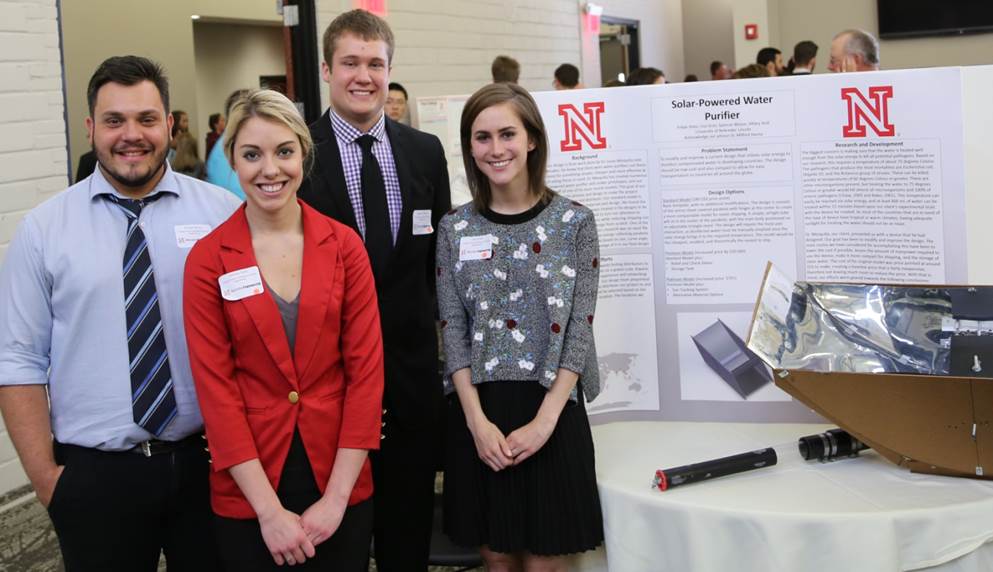 Team Members: Felipe Alves (BSEN, Santo Andre, Brazil), Hillary Stoll (BSEN, Lincoln, NE), Spencer Moore (BSEN, Columbus, NE), Lisa Gran (BSEN, Lincoln, NE)
Team Members: Felipe Alves (BSEN, Santo Andre, Brazil), Hillary Stoll (BSEN, Lincoln, NE), Spencer Moore (BSEN, Columbus, NE), Lisa Gran (BSEN, Lincoln, NE)
Faculty Consultant:Dr. Milford Hanna
Client:-
YearSpring 2015
The design of a device that purifies water using solar power and can be built, disassembled, and shipped in a cost-effective way in order to reach developing countries.TOP
Water Pressure
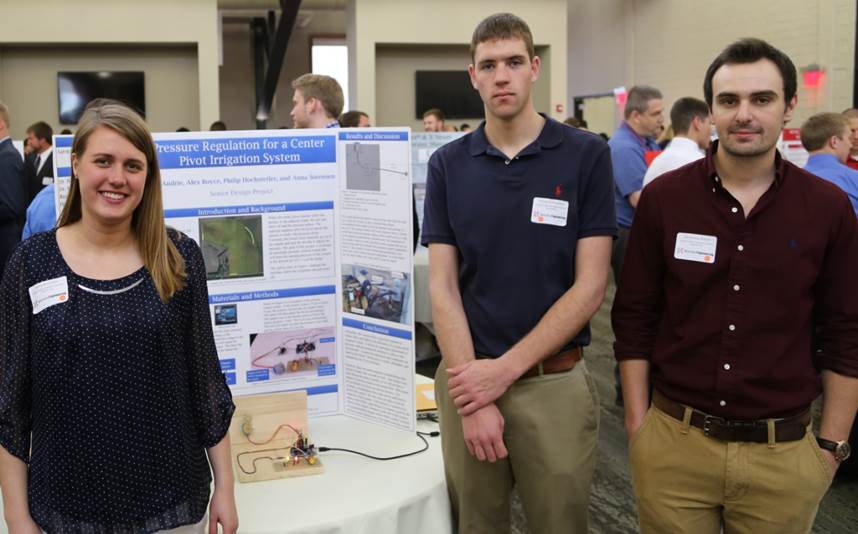 Team Members: Paula Andrie (BSEN, Gillette, WY) (Not in picture), Anna Sorensen (BSEN, Creighton, NE), Philip Hochstetler (BSEN, Strang, NE), Alexander Boyce (BSEN, Burlington, KS)
Team Members: Paula Andrie (BSEN, Gillette, WY) (Not in picture), Anna Sorensen (BSEN, Creighton, NE), Philip Hochstetler (BSEN, Strang, NE), Alexander Boyce (BSEN, Burlington, KS)
Faculty Consultant:Dr. Santosh Pitla
Client:-
YearSpring 2015
The goal of our project is to automatically regulate the water pressure in a pivot. When the end gun on a pivot shuts off, pressure spikes in the pivot. The main objective of our project is to design a control system that adjusts the pressure automatically by speeding up and slowing down the engine. We intend to do this with a microcontroller that will use a pressure sensor at the well to determine if and when the pressure is at the proper level and also use a stepper motor to adjust the engine speed.TOP
Lake Zorinsky Water Quality Basin Design
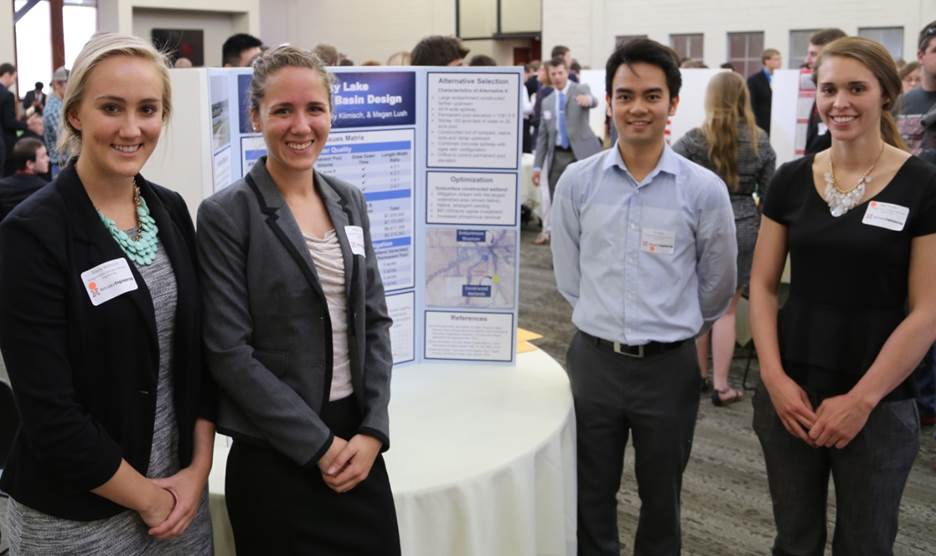 Team Members: Emily Klimisch (BSEN, Omaha, NE), Megan Lush (BSEN, Plymouth, MN), Tu Doan (BSEN, Lincoln, NE), Amy Fosler (BSEN, Panama, NE)
Team Members: Emily Klimisch (BSEN, Omaha, NE), Megan Lush (BSEN, Plymouth, MN), Tu Doan (BSEN, Lincoln, NE), Amy Fosler (BSEN, Panama, NE)
Faculty Consultant:Dr. Francisco Munoz Arriola
Client:-
YearSpring 2015
The project establishes the preliminary design for the last of four water quality basins for Lake Zorinsky in Omaha, Nebraska. After analyzing and updating four existing alternatives and offering a no-action alternative, a recommendation for action by the Papio-Missouri River Natural Resources District is made. Building upon the existing alternatives, an ideal design is presented, with a tiered approach to demonstrate the costs and effects associated with each tier.TOP
ASABE Fountain Wars: Task Two Basketball Shootout
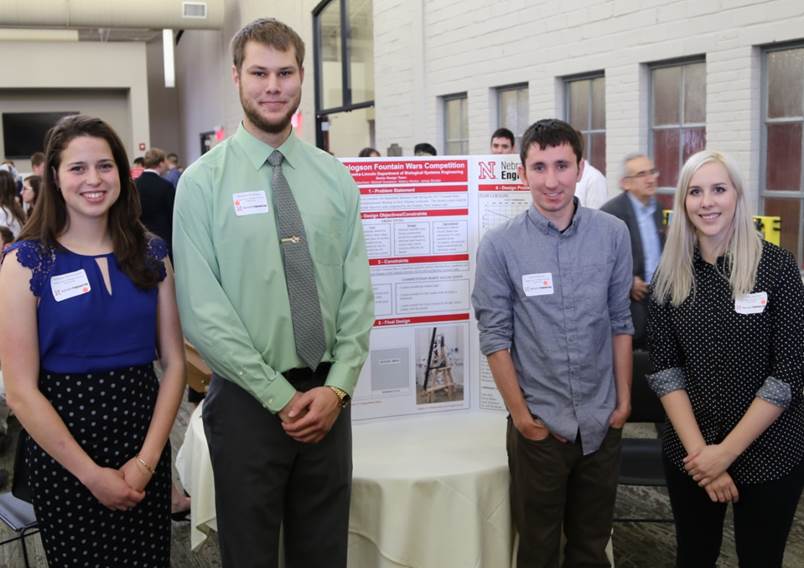 Team Members: Bethany Brittenham (BSEN, Superior, NE), Mitchell Goedeken (BSEN, Dodge City, KS), James Sinclair (BSEN, Omaha, NE), Mallory Morton (BSEN, Lincoln, NE)
Team Members: Bethany Brittenham (BSEN, Superior, NE), Mitchell Goedeken (BSEN, Dodge City, KS), James Sinclair (BSEN, Omaha, NE), Mallory Morton (BSEN, Lincoln, NE)
Faculty Consultant:Dr. Derek Heeren & Dr. Dean Eisenhauer
Client:-
YearSpring 2015
The Fountain Wars senior design team strives to maximize the number of competition points earned with a design for the Basketball Shootout technical task as outlined in the 2015 American Society of Agricultural and Biological Engineers (ASABE) Fountain Wars competition rulebook. Points are awarded on the following basis, and the team scoring highest earns 75 points. Five points are awarded when the flight of a launched ball enters the hoop set at 39.5 inches, and three points result if the ball hits the hoop or rim, but doesn’t complete the basket. If the ball travels for at least 4 feet, one point will be awarded. To maximize points, the team will develop a design to shoot all three provided balls into the hoop within the three-minute contest period. The hoop is positioned 6 feet from the edge of the pool. Within the $200 specified budget, the team will utilize piecewise comparison to develop an economic design. Factors of focus include accuracy, precision, and quality of materials with an emphasis on the use of biological materials. All energy used to move the ball must originate from work done by the pump. In preparation for competition requirements, the team develops a systematic method to assemble the materials quickly and without error. The material transport method serves as a guideline for natural breakdown of any large structural pieces. The team design will compete in July at the ASABE International Meeting in New Orleans, Louisiana. TOP
Whooping Crane Habitat
 Team Members:Dylan Horrocks (BSEN, Fremont, NE), Angel Lowery (BSEN, Omaha, NE), Chris Sullivan (BSEN, Aurora, NE), Thomas Bader (BSEN, Gresham, NE)
Team Members:Dylan Horrocks (BSEN, Fremont, NE), Angel Lowery (BSEN, Omaha, NE), Chris Sullivan (BSEN, Aurora, NE), Thomas Bader (BSEN, Gresham, NE)
Faculty Consultant:Dr. Derrel Martin
Client:-
YearSpring 2014
The Platte Rive Recovery Implementation Group purchases lands that can then serve as migratory and nesting habitat for Nebraska’s endangered bird populations. This project focuses on a piece of land new Overton, Neb., that will be restored to an ideal habitat for the migrating whooping crane. The design group will focus on maximizing unobstructed shallow wetland areas using as much of the natural topography as possible. A second part of the project involves providing means to allow seasonal flooding of a 20-arce portion of agricultural land to analyze whether this habitat would attract more migrating whooping cranes. TOP
UNL Challenge Course Water System
 Team Members:Nikolai Reitz (BSEN, Lincoln, NE), David Svoboda (BSEN, Holdrege, NE), Jason Thomas (BSEN, Papillion, NE), Cole Siever (BSEN, Lincoln, NE)
Team Members:Nikolai Reitz (BSEN, Lincoln, NE), David Svoboda (BSEN, Holdrege, NE), Jason Thomas (BSEN, Papillion, NE), Cole Siever (BSEN, Lincoln, NE)
Faculty Consultant:Dr. Thomas Franti
Client:-
YearSpring 2014
To the northeast of Lincoln, NE is a small outdoor recreation course. This course has both men’s and women’s bathroom facilities, with water provided by a nearby well. This well has become contaminated with salt, causing it to corrode the bathroom faucets and fixtures at an alarming rate. Our goal in this project is to provide several possible solutions, complete with cost estimates and corresponding analyses in relation to the problem of the quickly corroding bathroom fixtures. A secondary goal would be to provide a way of having drinking water at the facility so that it doesn’t have to be trucked in, as it is now. Our objectives are to reduce the number of fixtures replace per year, to have drinking water at the facility, to have the necessary water capacity, for our solution to have minimal environmental impact, and to keep cots as low as possible. We are expected to provide a detailed report of our findings and specifically the economic analysis of around three possible solutions. We plan on meeting the objectives and providing the product by performing extensive research and fact finding from knowledgeable individuals to decide which plans would be the best to implement. TOP
Fountain Wars Senior Design Team
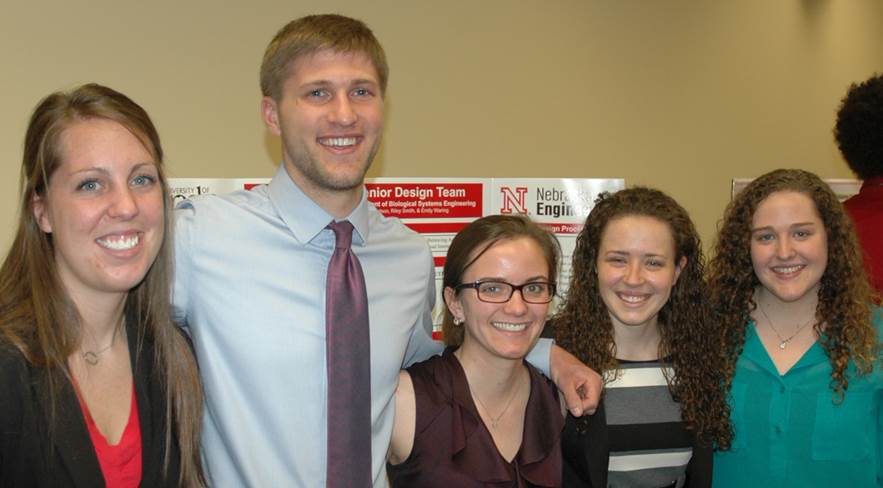 Team Members:Rebecca Nelson (BSEN, Seward, NE), Charlie Hinds (BSEN, Lincoln, NE), Emily Waring (BSEN, Omaha, NE), Kathryn Conroy (BSEN, Papillion, NE), Riley Smith (BSEN, Gering, NE)
Team Members:Rebecca Nelson (BSEN, Seward, NE), Charlie Hinds (BSEN, Lincoln, NE), Emily Waring (BSEN, Omaha, NE), Kathryn Conroy (BSEN, Papillion, NE), Riley Smith (BSEN, Gering, NE)
Faculty Consultant:Dr. Derek Heeren
Client:-
YearSpring 2014
The goal of our senior design project is to create a design to successfully compete in the American Society of Agricultural and Biological Systems Engineering Fountain Wars competition. Our design meets the requirements of the two technical tasks outlined by the Fountain Wars 2014 guidelines. These two technical task are: The Balancing Act and The Parachute Launch. Other criteria for the design include: creativity, use of organic materials, and aesthetic display. TOP
Camera Mount for an Unmanned Aircraft
 Team Members:Courtney Cahoy (BSEN, Grand Island, NE), Tim Dornbos (BSEN, Lincoln, NE), Nhat Tran (BSEN, Bien Hoa, Vietnam), Michael Bland (BSEN, North Platte, NE)
Team Members:Courtney Cahoy (BSEN, Grand Island, NE), Tim Dornbos (BSEN, Lincoln, NE), Nhat Tran (BSEN, Bien Hoa, Vietnam), Michael Bland (BSEN, North Platte, NE)
Faculty Consultant:Dr. Wayne Woldt
Client:-
YearSpring 2014
A camera mount was constructed to hold a thermal and optical camera inside the fuselage of a Tempest aircraft while reducing vibrations cause by flight. The mount must maintain a central focus point between both cameras at a height of 100 meters. The center of mass must not defer from the aircraft’s own center of mass to reduce flight interference. This requires the mount to be lightweight and centrally located in the fuselage. The design was made on SolidWorks and a prototype with possible deployment was produced using a 3D printer. TOP
Drinking Water
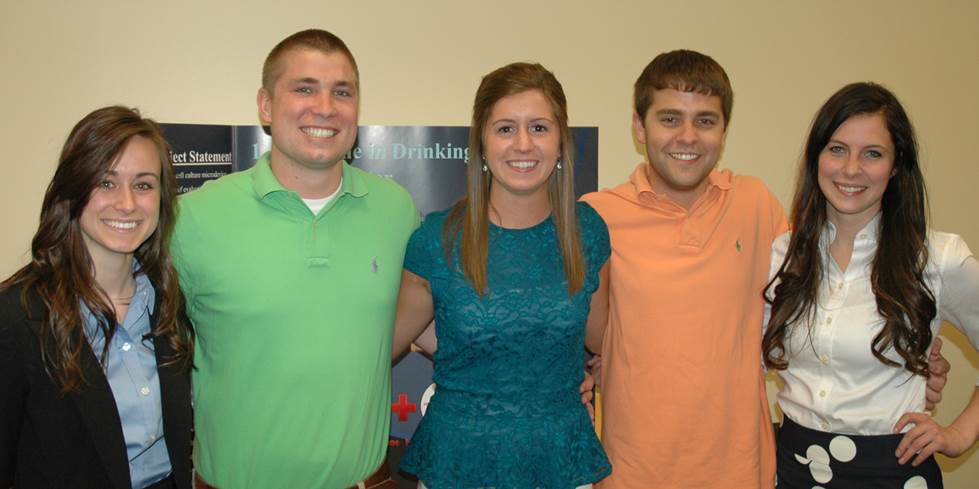 Team Members:Emily Hubl (BSEN, Lawrence, NE), Tyler Kruse (BSEN, Dakota Dunes, SD), Kathleen Kendall (BSEN, Omaha, NE), Nathan Giles (BSEN, La Vista, NE), Mackenzie Hruby (BSEN, Lincoln, NE)
Team Members:Emily Hubl (BSEN, Lawrence, NE), Tyler Kruse (BSEN, Dakota Dunes, SD), Kathleen Kendall (BSEN, Omaha, NE), Nathan Giles (BSEN, La Vista, NE), Mackenzie Hruby (BSEN, Lincoln, NE)
Faculty Consultant:Dr. Mark Riley
Client:-
YearSpring 2014
The goal of our project is to design a device that evaluates the toxicity of 1,4-dioxane in drinking water by using a cell culture microdevice. This device will accurately mimic the human digestive tract structurally and metabolically. TOP
PRRIP Whooping Crane Nesting
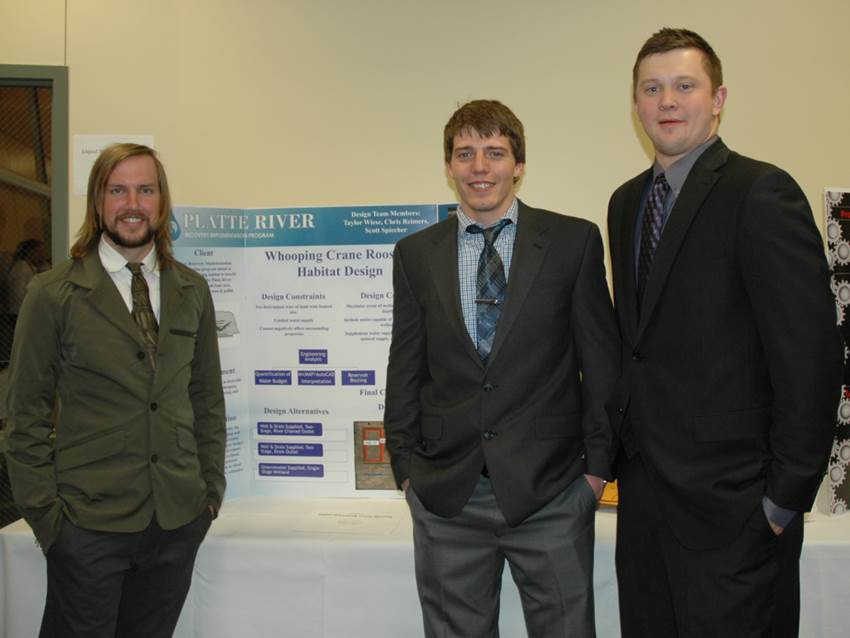 Team Members:Chris Reimers (AGEN, West Point, NE), Taylor Wiese (BSEN, Lincoln, NE), Scott Speicher (BSEN, Fremont, NE)
Team Members:Chris Reimers (AGEN, West Point, NE), Taylor Wiese (BSEN, Lincoln, NE), Scott Speicher (BSEN, Fremont, NE)
Faculty Consultant:Dr. Derril Martin
Client:Dr. Jerry Kenny, Platte River Recovery and Implementation Program
YearSpring 2013
This project, completed for the Platte River Recovery and Implementation Project, was focused on creating a migration habitat for remaining Whooping Crane Populations. Project aspects include water budget determination, site grading plan alternatives, and selection of water control structures and the corresponding design aspects associated with them. Once this project is completed, it will provide stable pallustrine wetland habitat for Whooping Crane roosting and feeding requirements. TOP
Trickle Creek East Subwatershed Flood Control and Water Quality Improvement Plan
 Team Members:Kara Scheel (BSEN, Lincoln, NE), Dana Becker (BSEN, Norfolk, NE), Chris Gice (BSEN, Lincoln, NE)
Team Members:Kara Scheel (BSEN, Lincoln, NE), Dana Becker (BSEN, Norfolk, NE), Chris Gice (BSEN, Lincoln, NE)
Faculty Consultant:Dr. Dennis Schulte
Client:Carter Hubbard, Olsson Associates
YearSpring 2013
The city of Sidney, NE projects growth and development – including a hospital and residential and commercial areas – in the near future. This will affect the watershed drainage into Lodgepole Creek. Our project works with a smaller subwatershed: currently underdeveloped and unable to convey runoff. Our goal was to model and implement retention structures suitable for proper drainage and flood control, to improve safety and water quality for the area. TOP
Stevens Creek Restoration
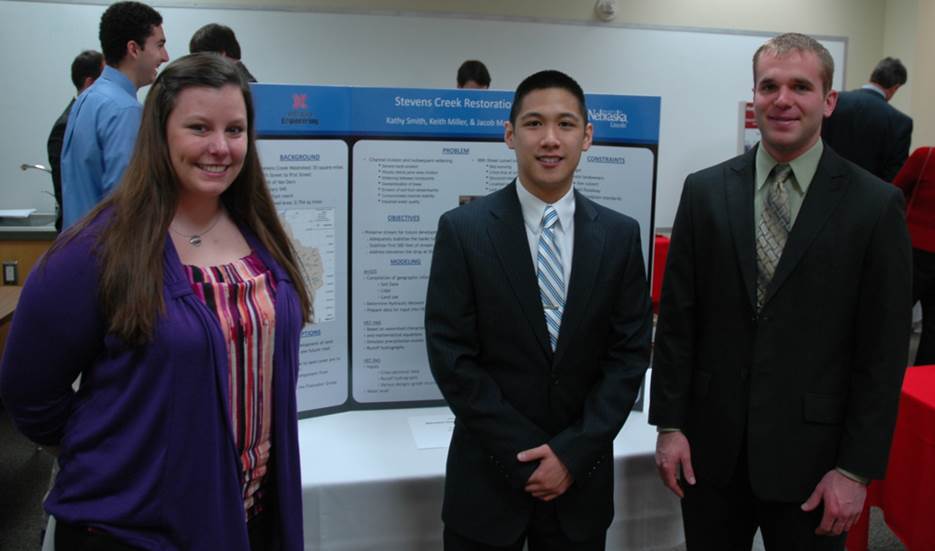 Team Members:Jacob Martinez (BSEN, Omaha NE), Katherine Smith (BSEN, Columbus, NE), Keith Miller (BSEN, BattleCreek, NE)
Team Members:Jacob Martinez (BSEN, Omaha NE), Katherine Smith (BSEN, Columbus, NE), Keith Miller (BSEN, BattleCreek, NE)
Faculty Consultant:Dr. Thomas Franti
Client:Marc Groff, Flatwater Group
YearSpring 2013
At the Stevens Creek Tributary Stabilization project site in east Lincoln near 98th and Van Dorn Street, the channel is undergoing bed and bank erosion due to historic incision events downstream. A proposed culvert installation may increase bed erosion, which will lower the channel bed elevation by two feet. The Flatwater Group developed a stabilization design plan and expects to begin construction this spring. Our parallel design could be used to evaluate design alternatives for future projects.TOP
Standing Column Well for Geothermal Energy
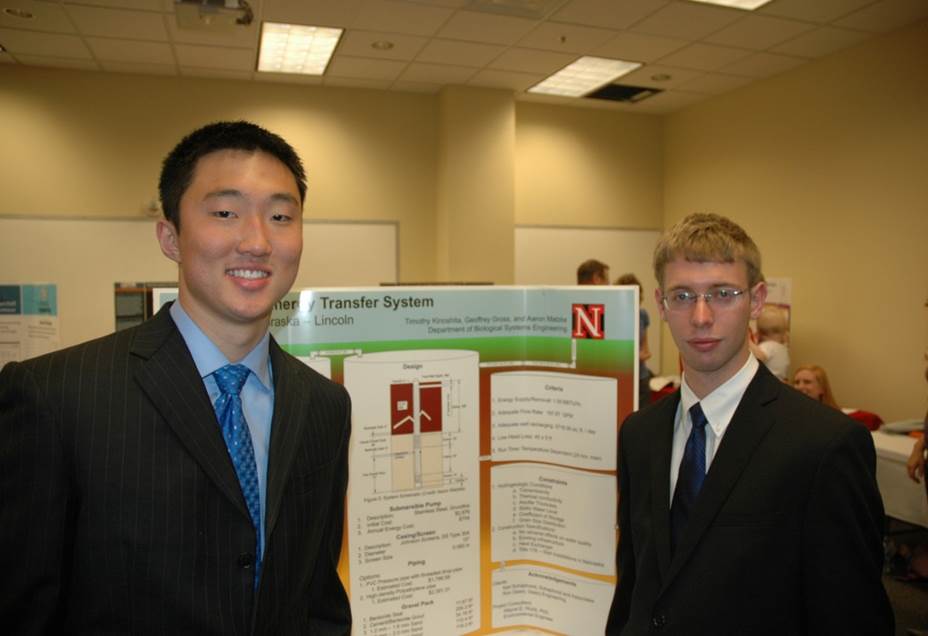 Team Members:Tim Kinoshita (BSEN, Chapell, NE),Geoffrey Gross (BSEN, Firth, NE)
Team Members:Tim Kinoshita (BSEN, Chapell, NE),Geoffrey Gross (BSEN, Firth, NE)
Faculty Consultant:Dr. Wayne Woldt
Client:Karl Schaphorst, Behlen/Aquaflow, Omaha, NE
YearSpring 2012
The use of open loop (also known as groundwater) heat pumps is gaining popularity as a highly efficient mode of heat exchange in geothermal systems. The technology is slowly making its way to the Midwestern United States with a recent installation at Hershey Public Schools in Hershey, Nebraska, in 2009. The objective of this project was to design another major open loop heat pump system at St. Joseph’s Villa in David City. Design specifications include all major water well components including submersible pump, casing and screens, and piping. TOP
Camp-A-Way Stream Restoration
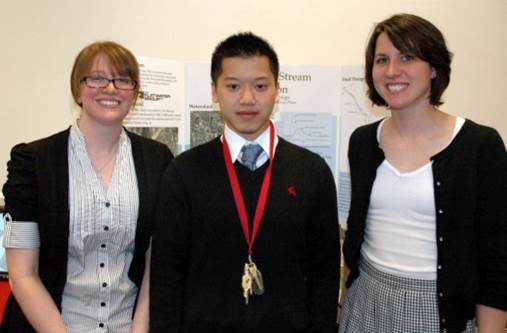 Team Members: Kristen Cope (BSEN, Aledo, TX ), Loc Pham (BSEN, Lincoln), Stacey Joy (BSEN, Vermillion, SD )
Team Members: Kristen Cope (BSEN, Aledo, TX ), Loc Pham (BSEN, Lincoln), Stacey Joy (BSEN, Vermillion, SD )
Faculty Consultant:Dr. Dean Eisenhauer
Client: Marc Groff, The Flatwater Group, Lincoln, NE
YearSpring 2011
A conceptual design was developed for a small channel running through Camp-A-Way Park in northwest Lincoln. This stream has eroded beyond acceptable limits, and Lincoln Parks and Recreation has contracted with the Flatwater Group to correct the problem with assistance from Senior Design students. The conceptual design is based upon the research of historical and current hydrological data, current stream stabilization methods, and other alternative solutions. Several possible channel designs, from natural to hard armoring, were evaluated with the consideration of the constraints, criteria, and client’s wants and needs. TOP
Prairie Pines Water Retention Structure
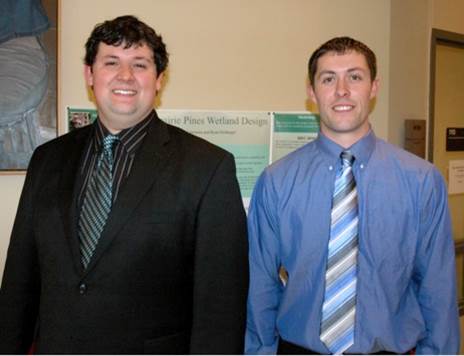 Team Members: Ryan Freiberger (BSEN, Topsham, ME), Ross Lawrence (AGEN, Waverly)
Team Members: Ryan Freiberger (BSEN, Topsham, ME), Ross Lawrence (AGEN, Waverly)
Faculty Consultant:Dr. Dennis Schulte
Client: Dr. Jim Brandle, University of Nebraska-Lincoln, School of Natural Resources
YearSpring 2011
Prairie Pines, a 145-acre property, has been transformed from farmland to an area of diverse woodland and grassland habitats. The purpose of Prairie Pines is to provide an environmental refuge, enhanced arboretum, and horticultural study area northeast of Lincoln, as well as to eventually integrate county extension services, community recreation, and wildlife research and education. The design objective is to specify a water retention structure, such as a pond or wetland, which will be used primarily for educational purposes, such as university research or field trips. It also needs to attract wildlife in addition to being cost effective. Constraints considered include the amount and quality of water available for the structure, soil types, and accessibility to the site. TOP